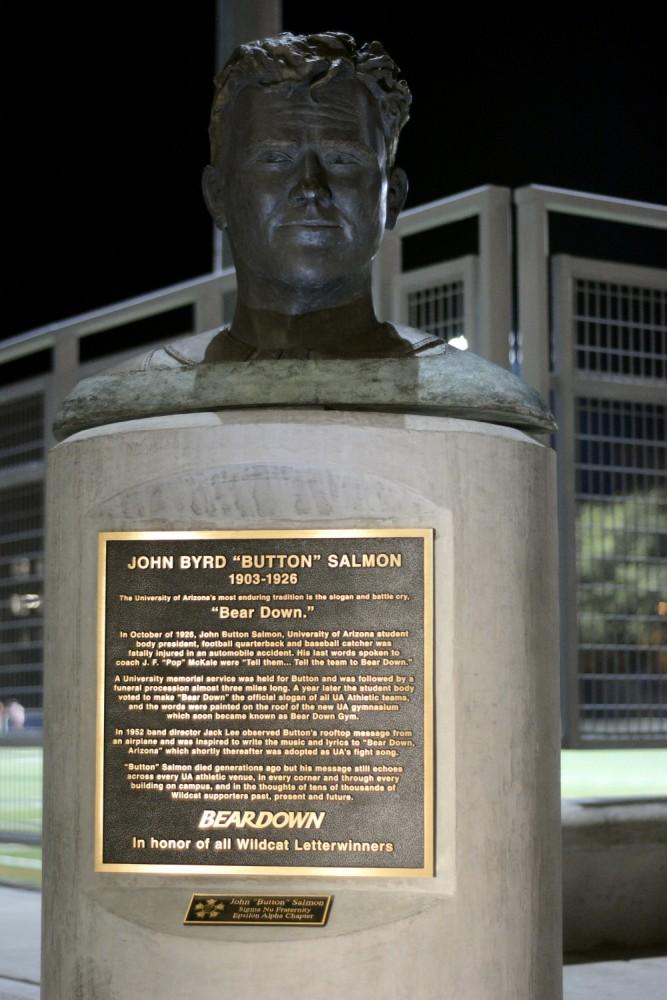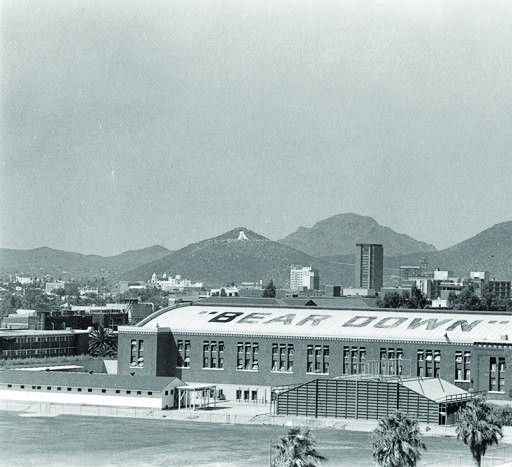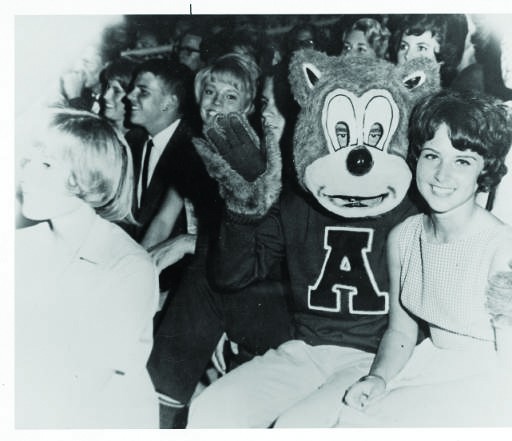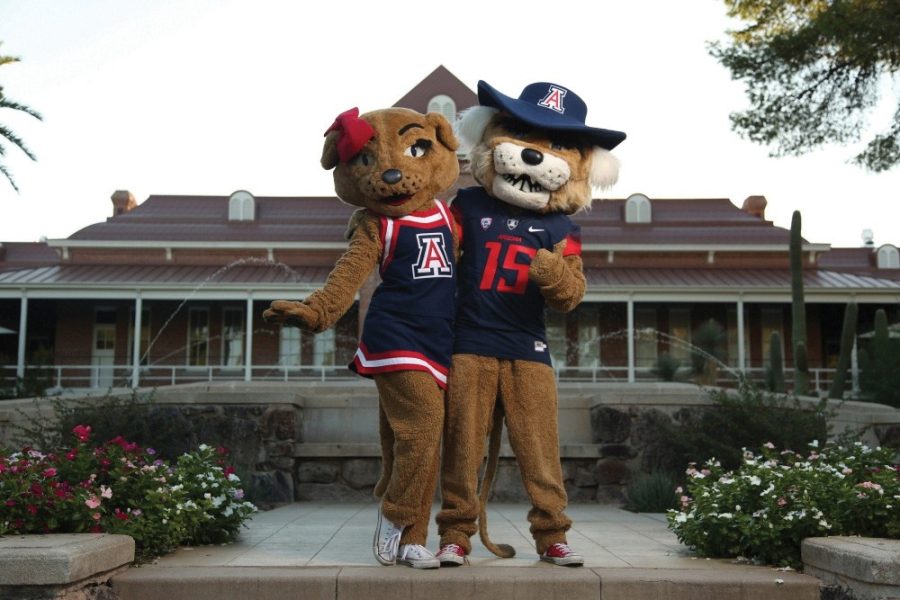Editor’s note: This article was produced as part of the Daily Wildcat‘s 2018 Campus Guide — the perfect resource for any incoming Wildcat. Whether you’re trying to find important dates, looking for a club to join or are interested in UA history and traditions, we’ll be there to help you get through your first semester. Welcome to the University of Arizona!
Since 1885, the University of Arizona has been a pillar of the Tucson community. The traditions and history of the campus run deep, with over 130 years of academic research, public advancements and an ever-growing sense of pride and spirit.
As an incoming student, here’s the UA history and traditions that you need to know.
John “Button” Salmon and the genesis of “Bear Down”
Let’s get to the important stuff first. The most frequent question asked by freshmen, newcomers and sports commentators is almost always: “Why do the Wildcats ‘Bear Down?’”

It’s a question with a remarkable answer, one that evokes the genesis of sports mythology at the UA.
After the first football game of the 1926 season, starting quarterback and student body president John Byrd “Button” Salmon was in a car accident that shattered his spine.
The popular student-athlete was taken to St. Mary’s Hospital, where every evening until his death legendary UA football coach James “Pops” McKale (McKale Center’s namesake) would visit him. On the night before Salmon died, McKale asked if he had a message for his fellow players.
In pain, Salmon whispered something to McKale. Salmon died the next morning. He was so revered that, after his death, his body laid in state for a day at the old UA assembly hall.
Later that week, the football team traveled to New Mexico State University for a game. Before kickoff, McKale gathered the players around him. Former Arizona lineman Martin Gentry, who was a member of the 1926 team, recalled the scene.
“It was a very emotional moment,” he said. “Mac said that he had asked Button if he had a message for the team. And Button had told him ‘Tell them … tell the team to bear down.’”
Bear Down continued — birth of a fight song
Technically, “Bear Down, Arizona,” the song that’s played every day at noon over the Student Union Memorial Center speakers, isn’t the official school fight-song.
That honor belongs to “Fight Wildcats Fight,” which was written in 1929 by Dugald “Douglas” Stanley Holsclaw. The lyrics declare, “Hail Arizona Wildcats, Fighting for old UA. A raging team of Wildcats, growling for the fray. There’s not a team can stop them, when the ball goes into play, so Fight! Team! Fight with all your might, and win today.”
Admittedly, pretty uninspired stuff. Luckily, the unofficial school fight song, composed by Jack K. Lee in 1952, has a little more fight and a cool story behind it.
Lee was applying for the job of band director at the university, and, after his interview, had flown home to Michigan to wait on the UA’s response. On the flight home, his plane passed over Bear Down Gym, and he saw the famous motto painted on the gym’s roof for the first time.

Overcome with inspiration, Lee reached for an air-sickness bag and a pen and came up with this: “Bear down, Arizona! Bear down, red and blue! Bear down, Arizona! Hit ‘em hard let ‘em know who’s. Bear down, Arizona! Bear down, red and blue! Go, go, Wildcats go! Arizona, bear down!”
The rest, as they say, is history. To note: When playing Arizona State, it’s fine to replace “hit ‘em hard, let ‘em know who’s who,” with “beat the hell out of ASU.”
The Student Union Memorial Center — a connection to the U.S.S. Arizona
While its evolution continues, the Student Union Memorial Center has always served as the center of campus life. Now one of the largest student unions in the country, its genesis is decidedly humbler.
University President Cloyd Heck Marvin proposed the idea of a student union in 1923, but it wasn’t until 1938 that a committee was formed to raise funds for the project. That effort stalled due to the start of World War II and the UA continued on without a student union for the first half of the 20th Century.
Then, in 1951, 28 years after it was first proposed and $1.2 million later, the University of Arizona Student Union Memorial Center was completed and opened to the UA community.
Since its inception, the Union (as it’s known on campus) has served as more than a cafeteria and meeting space. At its opening, the original Union featured a bell tower harboring a bell recovered from the wreckage of the U.S.S. Arizona. The nearly 2,000-pound bell, still found on the Union’s fourth floor, is rung seven times the third Wednesday of the month at 12:07p.m., the time the attack began.
In 2003, after two full years of renovation and nearly doubling its square footage, the Union reopened, sporting a new design inspired by the profile of the states’ namesake battleship. The Union now serves as a living memorial to the men and women who served and gave their lives for their country.
Wilbur and Wilma: A love story
Get used to seeing this feline couple around campus. Married mascots Wilbur T. and Wilma T. (the “T” stands for “The”) Wildcat are the official UA mascots and easily the coolest cats in town. Their story, like their romance, is eternal.
Wilbur began as a live bobcat called Rufus Arizona, named for the school’s then-President, Rufus von KleinSmid (who we assume had the facial hair of an 1800s train conductor).
After Rufus died in 1916, the university went without an official mascot for a while. Then, in a football game against Texas Tech on Nov. 7, 1959, eventual UA graduate Ed Stuckenoff donned the Wildcat costume and became the first Wilbur in Arizona history.

Wilma came along much like Eve as told in the Bible: out of a male body. Costume designers were attempting to make another Wilbur outfit, only to stumble upon the genius of the female wildcat form.
Eventually, the two felines were set up on a blind date during a March 1, 1986 basketball game. Wilbur, sensing early on that Wilma was “the one,” proposed and eventually married Wilma on Nov. 21, 1986 in front of elated Wildcats during the annual football game against ASU.
Today, you can catch the couple at most major UA athletic events and all over Tucson.









